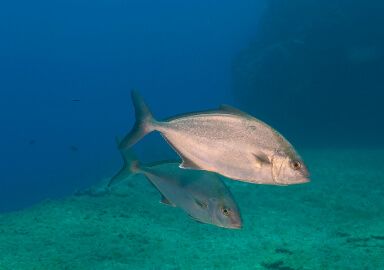Amberjack
Amberjacks are large to very large streamlined, torpedo-shaped fish, members of the Carangidae family, which is often regarded as the top game fish group.
View 109 listings
109
listings
–
price starting from
24
countries
–
to the nearest trip
Where and When?
The amberjack is distributed all over the world and can be found in the warmer areas of all major oceans, plus it is sometimes found in or migrates to cooler areas such as the waters off Nova Scotia. In Australia it can be caught almost right round the country and it is a popular angling species in many localities around the Australian shore. It is an important angling species in much of both North and South America in both the Atlantic and Pacific Oceans. Many resorts around Florida and throughout much of the Caribbean Sea offer good amberjack fishing opportunities.
Although it can sometimes be enticed by chumming to rise to near the surface, amberjack are mostly caught at considerable depths. Smaller individuals are generally found in shallower waters while the really big fish are almost exclusively found in very deep water. The species can be caught throughout the year in most areas.
About Amberjack
There are several amberjack species but the greater amberjack, Seriola dumerili, is by far the most popular and important. Their streamlined, torpedo-shaped body is blue or grey above, silvery below with a characteristic amber stripe along the middle. They can grow to about 190 cm (6.2 feet) in length, with a maximum mass of approximately 80 kg (176 lb), during a lifespan of around 15 years. Female fish are much larger than males and amberjack are summer spawners. Although a predator themselves, they fall prey to sharks and yellowfin tuna.
Amberjacks eat mostly fish, sometimes of relatively large size, but they also take squids, shrimps and other invertebrates. They are often associated with wrecks and reefs and seem to spend most of their time fairly close to the ocean floor in depths of down to 360 meters. They have various names in different parts of their range, such as “donkey fish”, “Samson fish” and “pez fuerte” (strong fish), but all these names allude to the ability of this fish to give an incredibly strong, long, memorable fight.
How to Catch?
Amberjacks are nearly always caught from boats and larger specimens rarely move close to the shore. There are several different ways to catch them but jigging is usually the most common and popular method as it is often the most efficient and speedy way of getting a suitable bait or lure down deep enough to target this species. Heavy tackle is essential to land large amberjacks and the powerful names given to this species are well earned. Line of between 50 and 80 lbs. is recommended plus a strong rod and robust reel.
Amberjacks do not have sharp teeth and thus a wire trace is not necessary. It is, however, very important to try and control the fish so that it does not escape into the wreck, reef or other structure around which they often live. Amberjack often gather where ocean currents flow together or the ocean bottom drops away and baitfish congregate. Good, well maintained equipment is essential as a fight from a large amberjack, which could be the angler’s fight of a lifetime, can often take well over an hour of almost constant powerful fighting.










